Abstract
Pooled serum from hamsters immune to syphilitic infection conferred complete protection on recipient hamsters challenged with Treponema pallidum subsp. endemicum. Cutaneous lesions did not develop, and the recipients' lymph nodes weighed less than those of controls and contained no treponemes. Treponemicidal activity in the pooled immune serum was relatively high. When treponemes were incubated in immune serum and complement and the suspension was then inoculated into hamsters, recipients developed neither lesions nor enlarged lymph nodes teeming with treponemes. With hamsters already infected for several weeks, however, immune serum failed to impair or influence the progression of syphilis. Treponemes were eliminated only when immune serum was administered within a short time of syphilitic infection. These results demonstrate that hamsters develop an effective serum-mediated treponemicidal response, but this response is not sufficient to eliminate treponemes at the primary foci of infection.
Full text
PDF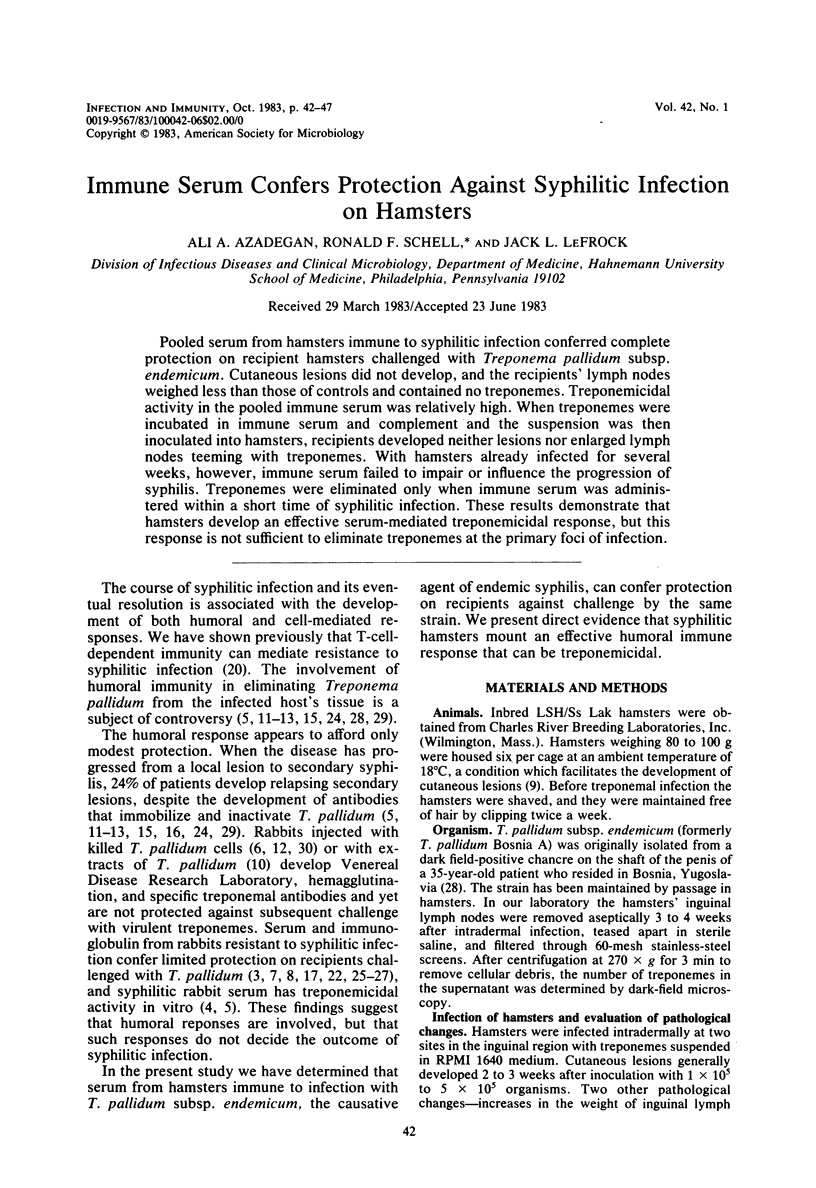
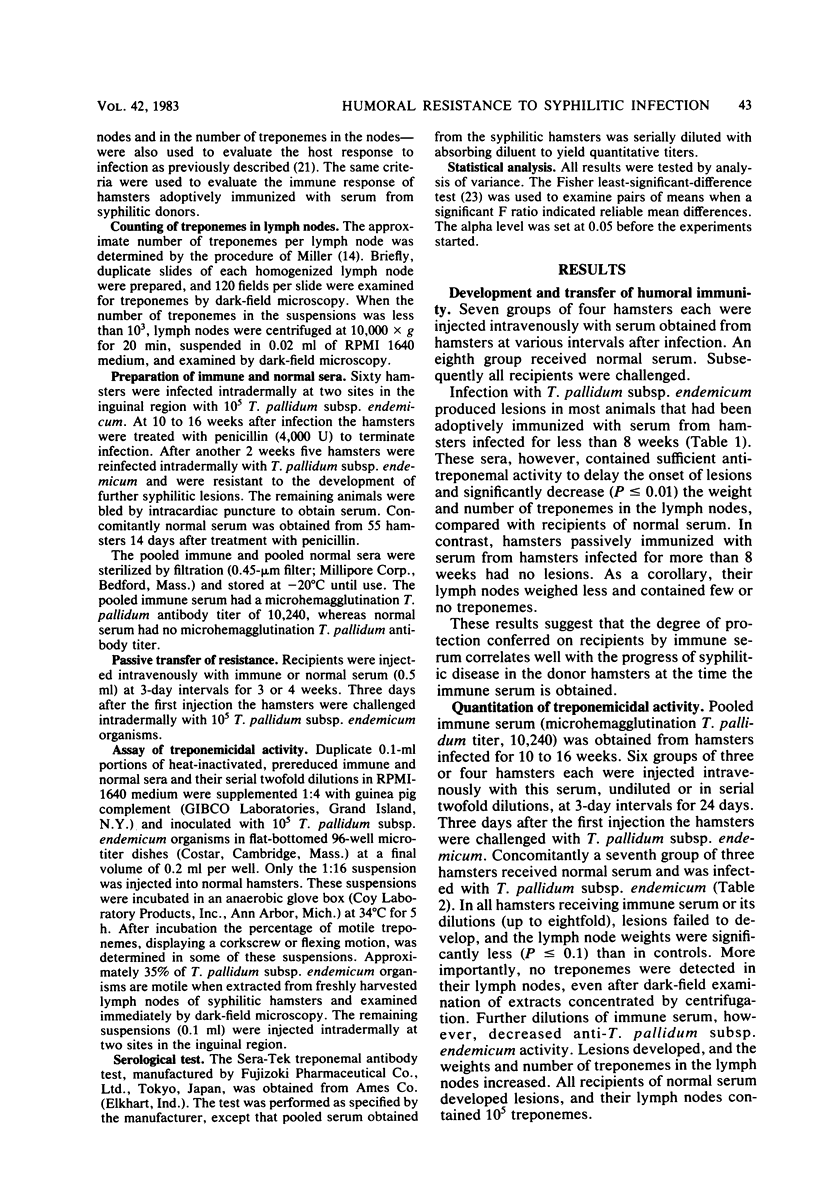
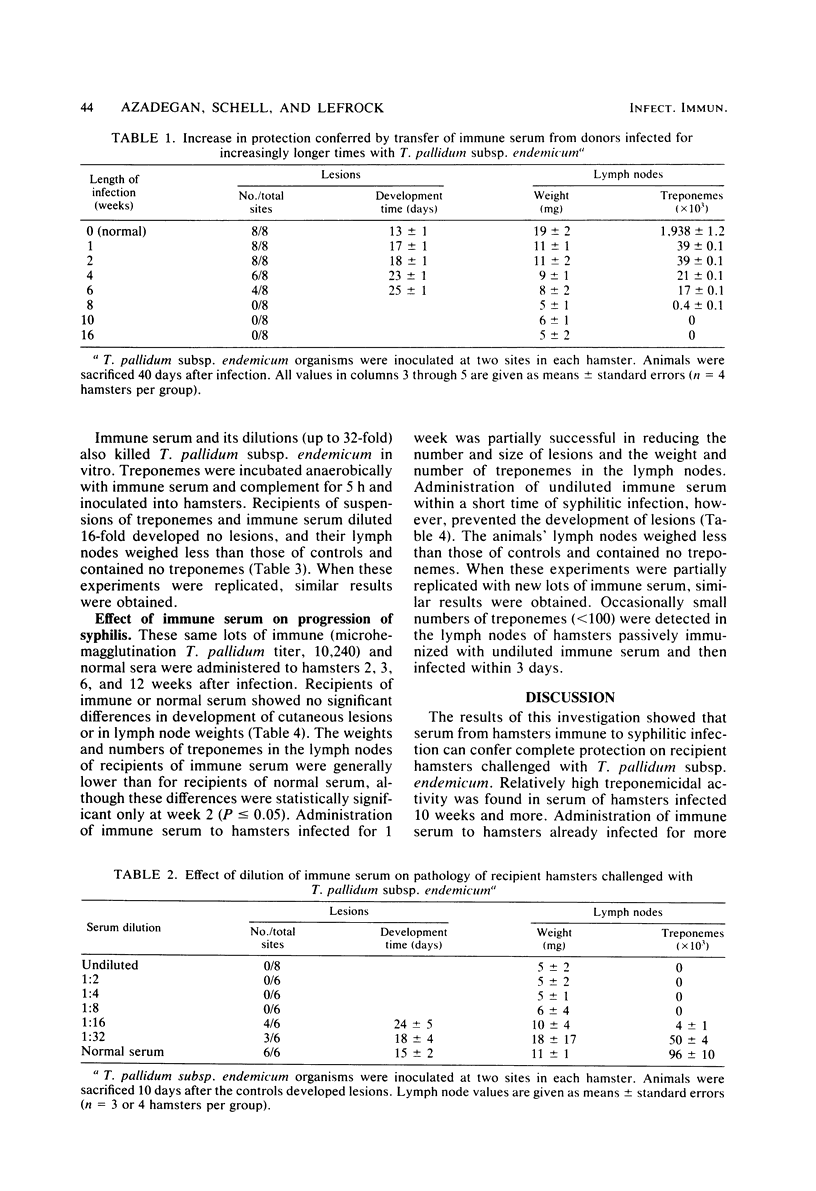
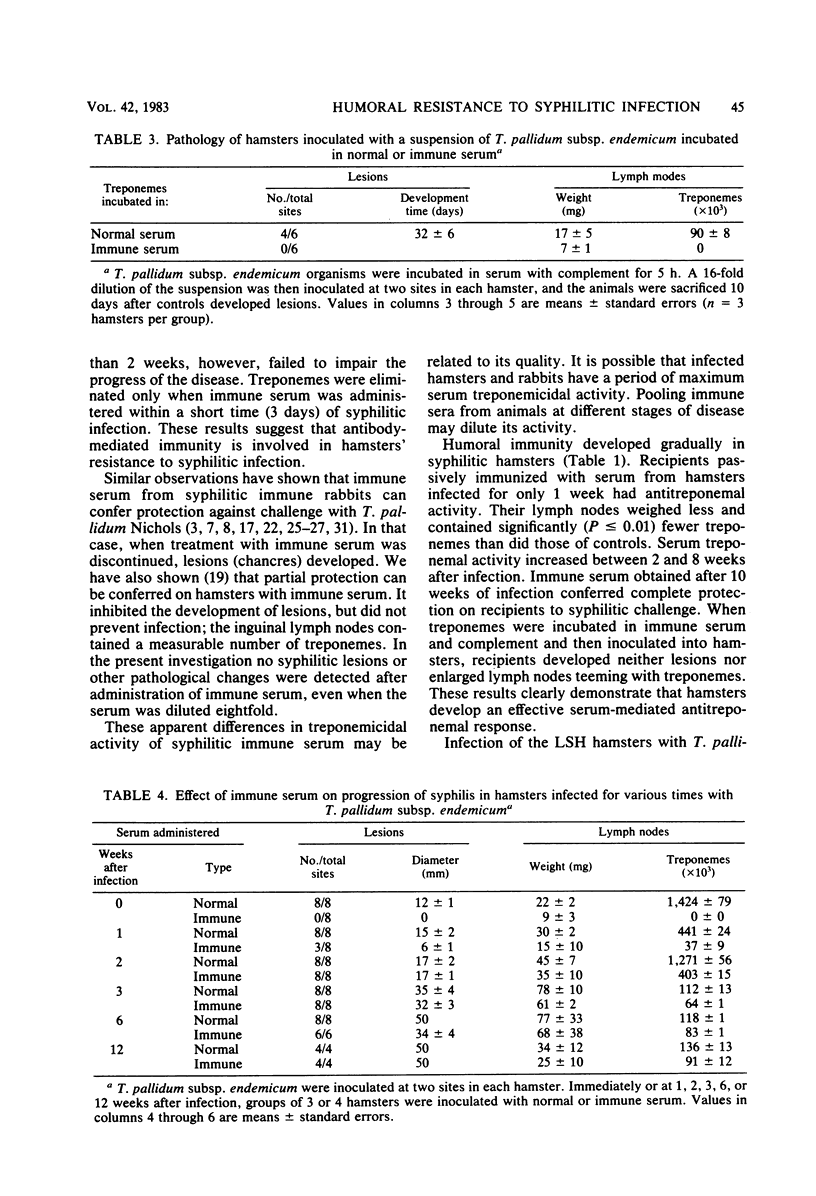
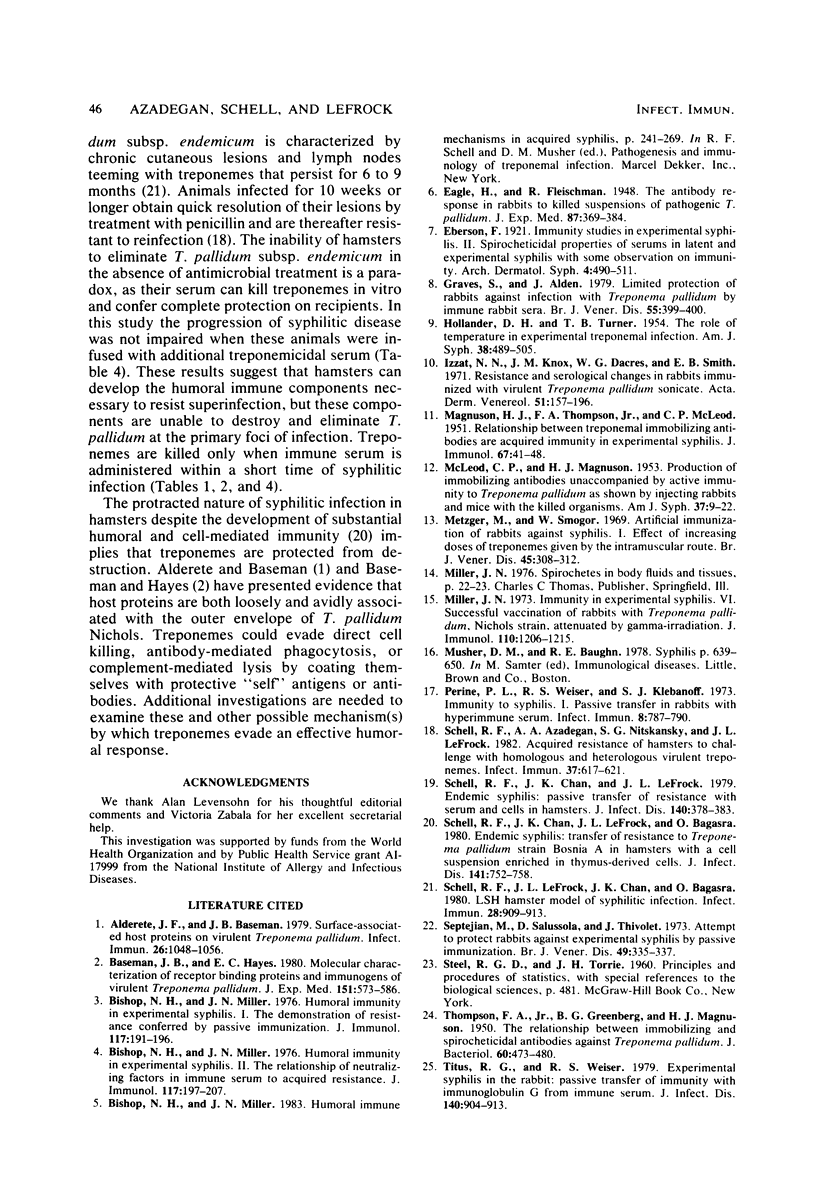
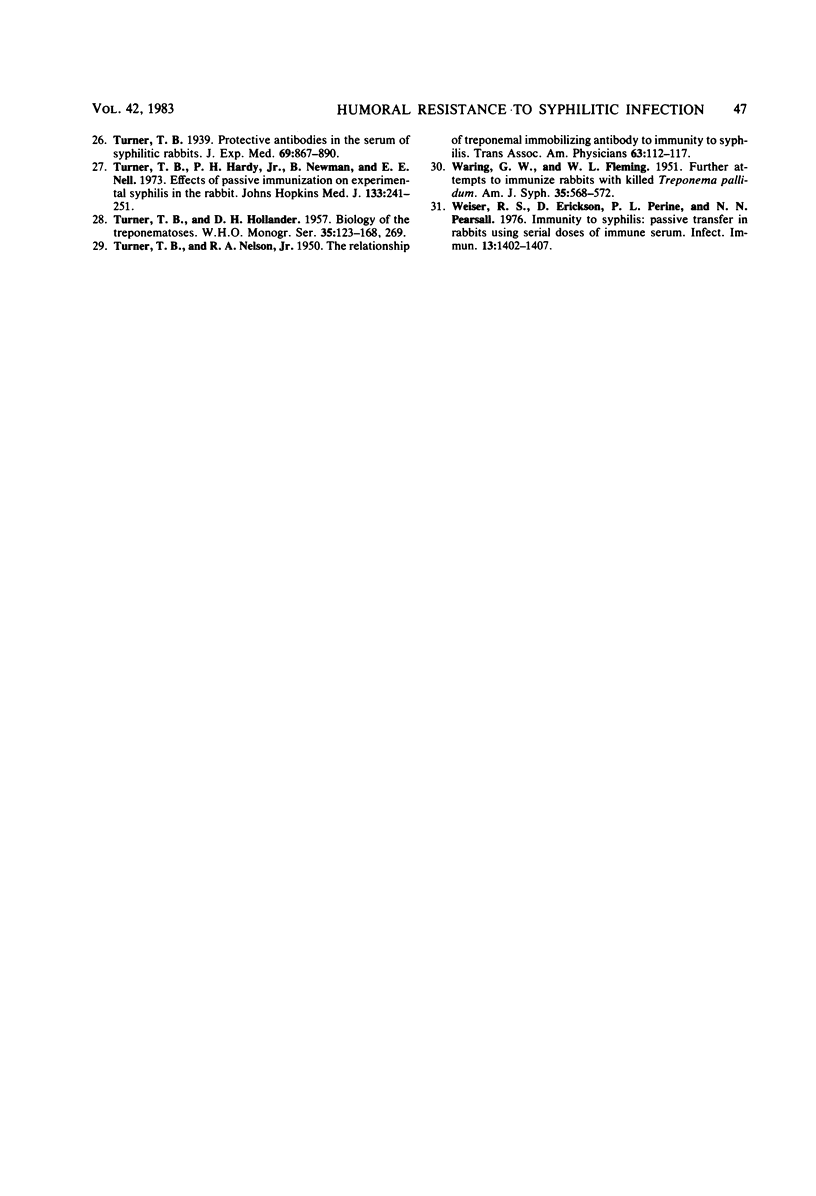
Selected References
These references are in PubMed. This may not be the complete list of references from this article.
- Alderete J. F., Baseman J. B. Surface-associated host proteins on virulent Treponema pallidum. Infect Immun. 1979 Dec;26(3):1048–1056. doi: 10.1128/iai.26.3.1048-1056.1979. [DOI] [PMC free article] [PubMed] [Google Scholar]
- Baseman J. B., Hayes E. C. Molecular characterization of receptor binding proteins and immunogens of virulent Treponema pallidum. J Exp Med. 1980 Mar 1;151(3):573–586. doi: 10.1084/jem.151.3.573. [DOI] [PMC free article] [PubMed] [Google Scholar]
- Bishop N. H., Miller J. N. Humoral immunity in experimental syphilis. I. The demonstration of resistance conferred by passive immunization. J Immunol. 1976 Jul;117(1):191–196. [PubMed] [Google Scholar]
- Bishop N. H., Miller J. N. Humoral immunity in experimental syphilis. II. The relationship of neutralizing factors in immune serum to acquired resistance. J Immunol. 1976 Jul;117(1):197–207. [PubMed] [Google Scholar]
- EAGLE H., FLEISCHMAN R. The antibody response in rabbits to killed suspensions of pathogenic T. pallidum. J Exp Med. 1948 May 1;87(5):369–384. doi: 10.1084/jem.87.5.369. [DOI] [PMC free article] [PubMed] [Google Scholar]
- Graves S., Alden J. Limited protection of rabbits against infection with Treponema pallidum by immune rabbit sera. Br J Vener Dis. 1979 Dec;55(6):399–403. doi: 10.1136/sti.55.6.399. [DOI] [PMC free article] [PubMed] [Google Scholar]
- HOLLANDER D. H., TURNER T. B. The role of temperature in experimental treponemal infection. Am J Syph Gonorrhea Vener Dis. 1954 Nov;38(6):489–505. [PubMed] [Google Scholar]
- Izzat N. N., Knox J. M., Dacres W. G., Smith E. B. Resistance and serological changes in rabbits immunized with virulent Treponema pallidum sonicate. Acta Derm Venereol. 1971;51(2):157–160. [PubMed] [Google Scholar]
- MAGNUSON H. J., THOMPSON F. A., Jr, McLEOD C. P. Relationship between treponemal immobilizing antibodies and acquired immunity in experimental syphilis. J Immunol. 1951 Jul;67(1):41–48. [PubMed] [Google Scholar]
- MCLEOD C. P., MAGNUSON H. J. Production of immobilizing antibodies unaccompanied by active immunity to Treponema pallidum as shown by injecting rabbits and mice with the killed organisms. Am J Syph Gonorrhea Vener Dis. 1953 Jan;37(1):9–22. [PubMed] [Google Scholar]
- Metzger M., Smogór W. Artificial immunization of rabbits against syphilis. I. Effect of increasing doses of treponemes given by the intramuscular route. Br J Vener Dis. 1969 Dec;45(4):308–312. doi: 10.1136/sti.45.4.308. [DOI] [PMC free article] [PubMed] [Google Scholar]
- Miller J. N. Immunity in experimental syphilis. VI. Successful vaccination of rabbits with Treponema pallidum, Nichols strain, attenuated by -irradiation. J Immunol. 1973 May;110(5):1206–1215. [PubMed] [Google Scholar]
- Perine P. L., Weiser R. S., Klebanoff S. J. Immunity to syphilis. I. Passive transfer in rabbits with hyperimmune serum. Infect Immun. 1973 Nov;8(5):787–790. doi: 10.1128/iai.8.5.787-790.1973. [DOI] [PMC free article] [PubMed] [Google Scholar]
- Schell R. F., Azadegan A. A., Nitskansky S. G., LeFrock J. L. Acquired resistance of hamsters to challenge with homologous and heterologous virulent treponemes. Infect Immun. 1982 Aug;37(2):617–621. doi: 10.1128/iai.37.2.617-621.1982. [DOI] [PMC free article] [PubMed] [Google Scholar]
- Schell R. F., Chan J. K., Le Frock J. L. Endemic syphilis: passive transfer of resistance with serum and cells in hamsters. J Infect Dis. 1979 Sep;140(3):378–383. doi: 10.1093/infdis/140.3.378. [DOI] [PubMed] [Google Scholar]
- Schell R. F., Chan J. K., LeFrock J. L., Bagasra O. Endemic syphilis: transfer of resistance to Treponema pallidum strain Bosnia A in hamsters with a cell suspension enriched in thymus-derived cells. J Infect Dis. 1980 Jun;141(6):752–758. doi: 10.1093/infdis/141.6.752. [DOI] [PubMed] [Google Scholar]
- Schell R. F., LeFrock J. L., Chan J. K., Bagasra O. LSH hamster model of syphilitic infection. Infect Immun. 1980 Jun;28(3):909–913. doi: 10.1128/iai.28.3.909-913.1980. [DOI] [PMC free article] [PubMed] [Google Scholar]
- Sepetjian M., Salussola D., Thivolet J. Attempt to protect rabbits against experimental syphilis by passive immunization. Br J Vener Dis. 1973 Aug;49(4):335–337. doi: 10.1136/sti.49.4.335. [DOI] [PMC free article] [PubMed] [Google Scholar]
- THOMPSON F. A., Jr, GREENBERG B. G., MAGNUSON H. J. The relationship between immobilizing and spirocheticidal antibodies against Treponema pallidum. J Bacteriol. 1950 Oct;60(4):473–480. doi: 10.1128/jb.60.4.473-480.1950. [DOI] [PMC free article] [PubMed] [Google Scholar]
- TURNER T. B., NELSON R. A., Jr The relationship of treponemal immobilizing antibody to immunity in syphilis. Trans Assoc Am Physicians. 1950;63:112–117. [PubMed] [Google Scholar]
- Titus R. G., Weiser R. S. Experimental syphilis in the rabbit: passive transfer of immunity with immunoglobulin G from immune serum. J Infect Dis. 1979 Dec;140(6):904–913. doi: 10.1093/infdis/140.6.904. [DOI] [PubMed] [Google Scholar]
- Turner T. B., Hardy P. H., Jr, Newman B., Nell E. E. Effects of passive immunization on experimental syphilis in the rabbit. Johns Hopkins Med J. 1973 Nov;133(5):241–251. [PubMed] [Google Scholar]
- Turner T. B. PROTECTIVE ANTIBODIES IN THE SERUM OF SYPHILITIC RABBITS. J Exp Med. 1939 May 31;69(6):867–890. doi: 10.1084/jem.69.6.867. [DOI] [PMC free article] [PubMed] [Google Scholar]
- WARING G. W., Jr, FLEMING W. L. Further attempts to immunize rabbits with killed Treponema pallidum. Am J Syph Gonorrhea Vener Dis. 1951 Nov;35(6):568–572. [PubMed] [Google Scholar]
- Weiser R. S., Erickson D., Perine P. L., Pearsall N. N. Immunity to syphilis: passive transfer in rabbits using serial doses of immune serum. Infect Immun. 1976 May;13(5):1402–1407. doi: 10.1128/iai.13.5.1402-1407.1976. [DOI] [PMC free article] [PubMed] [Google Scholar]


